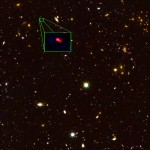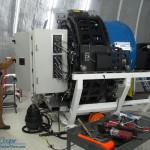W. M. Keck Observatory press release…
University of Texas at Austin astronomer Steven Finkelstein has led a team that has discovered and measured the distance to the most distant galaxy ever found, using the W. M. Keck Observatory on the summit of Mauna Kea, Hawaii. The galaxy is seen as it was at a time just 700 million years after the Big Bang. The result will be published in the Oct. 24 issue of the journal Nature.
Initial observations from NASA’s Hubble Space Telescope identified many candidates for galaxies in the early universe, but this galaxy is the earliest and most distant definitively confirmed, using the 10-meter, Keck I telescope fitted with Keck Observatory’s newest instrument, MOSFIRE.

Astronomers can study how galaxies evolve because light travels at a finite speed, about 186,000 miles per second. Thus when we look at distant objects, we see them as they appeared in the past. The farther astronomers can push their observations, the farther into the past they can see.
“We want to study very distant galaxies to learn how they change with time,” Finkelstein said. “This helps us understand how the Milky Way came to be.”
The devil is in the details, however, when it comes to making conclusions about galaxy evolution, which means astronomers must employ the most rigorous methods and utilize the most powerful instruments to measure the distances to these galaxies in order to understand at what epoch of the universe they are seen.
The Hubble CANDELS survey uses colors from HST images to identify potentially distant galaxies. Finkelstein’s team selected z8_GND_5296, and dozens of others, for follow-up spectroscopy from the approximately 100,000 CANDELS galaxies. This method is good, but not foolproof, Finkelstein says. Using colors to sort galaxies is tricky because more nearby objects can masquerade as distant galaxies.
In order to accurately determine the distance to these galaxies, astronomers use spectroscopy to measure how much a galaxy’s light wavelengths have shifted toward the red end of the spectrum over their travels from the galaxy to Earth. This phenomenon is called “redshift”, and is due the expansion of the universe.
The team used Keck Observatory’s Keck I telescope in Hawaii, one of the two largest optical/infrared telescopes in the world, to measure the redshift of z8_GND_5296 at 7.51, the highest galaxy redshift ever confirmed. The redshift means this galaxy hails from a time only 700 million years after the Big Bang.

In addition to its great distance, the team’s observations showed that the galaxy z8_GND_5296 is forming stars extremely rapidly — producing stars at a rate 150 times faster than our own Milky Way galaxy. This new distance record-holder lies in the same part of sky as the previous record-holder (redshift 7.2), which also happens to have a very high rate of star-formation.
“So we’re learning something about the distant universe,” Finkelstein said. “There are way more regions of very high star formation than we previously thought. … There must be a decent number of them if we happen to find two in the same area of the sky.”
In addition to their studies with Keck, the team also observed z8_GND_5296 in the infrared with NASA’s Spitzer Space Telescope. Spitzer measured how much ionized oxygen the galaxy contains, which helps pin down the rate of star formation. The Spitzer observations also helped rule out other types of objects that could masquerade as an extremely distant galaxy, such as a more nearby galaxy that is particularly dusty.
Other team members include Bahram Mobasher of the University of California, Riverside; Mark Dickinson of the National Optical Astronomy Observatory; Vithal Tilvi of Texas A&M; and Keely Finkelstein and Mimi Song of UT-Austin.

